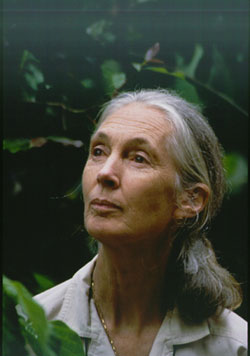Dr. Jane Goodall

Dr. Jane Goodall. Source: Twin Cities Public Television.
Dr. Jane Goodall is a name known in every household, but how much do you know about this amazing woman? She was born in 1934 in London. When she was two years old, her favorite toy was a stuffed chimpanzee. When she was four years old, she started asking very curious questions, such as, “where to eggs come from?” At the age of 10, her favorite books were Dr. Dolittle, Jungle Book, and Tarzan. Is it any surprise she would go on and research chimpanzees?
But her journey was not an easy one. By the time she was 23 years old, she decided to take a boat trip to Kenya to meet Dr. Louis Leakey at the Olduvai Gorge to dig up fossils and conduct anthropological research. Dr. Leakey had been looking for someone to go to Tanzania and study the chimpanzees there. Not much was known about wild chimpanzees at that time, and it might give clues about our human evolution. Dr. Leakey could see that Jane had a lot of stamina, was resourceful and patient, and of course was extremely interested in wild animals. But he was very cautious about letting her go alone to begin this new research, so he required that she have a chaperone to protect and look over her in the African forests. She didn’t have to go very far to find that chaperone–she asked the person who had always encouraged her, telling her she could make her dreams reality if she worked hard and believed in herself. That person was Jane Goodall’s mother.
In the summer of 1960, Dr. Goodall arrived on the shores of Lake Tanganyika in Tanganyika (later to become Tanzania), East Africa. She immediately began to study the chimpanzees in what is now Gombe National Park. In October of that year, she make a significant observation from a distance–she saw chimps using and making tools to get at termites in termite mounds. The chimp would strip leaves off of a branch, lick the branch, then insert the stick in a termite mound. The termites would attach to the stick, and the chimp could then lick them off and repeat the procedure.
Now we have learned that chimps use a variety of tools, hunt for meat, and have diverse personalities. This was one of the most significant discoveries Dr. Goodall made, as it was believed that man was the only species with the intelligence to create and use tools.
In, 1967 the Gombe Stream Research Center (GSRC) was founded to coordinate the study of the wild chimpanzee populations. Dr. Goodall also founded the Jane Goodall Institute which advances the power of individuals to take informed and compassionate action to improve the environment of all living things. The Institute also has the Roots & Shoots global youth program, which helps young people to learn about problems in their communities and the world and then take action toward solving those problems. There are today more than 7,000 Roots & Shoots groups in 87 countries. Young people give Dr. Goodall great hope for the future. She loves to talk with children in Roots & Shoots and other youths about the work they’re doing to change the world.
Despite all of Dr. Goodall’s successes, the news for the chimpanzee population isn’t good. Ten years ago, it was estimated that ~250,000 chimps existed in the wild. Today, the estimate is down to ~200,000 chimps. Dr. Goodall and others are taking aggressive efforts to increase the numbers of chimpanzees through the planting of trees, encouraging women not to purchase bushmeat, and educating the logging industry to find other sources of protein for their staff.
Dr. Jane Goodall has maintained the longest field study of any animal species in their natural surroundings for over 40 years. She also maintains a philosophy of noninterference with her research, watching chimps from a distance through binoculars and allowing them to make the initial contact with her. She continues today pursuing her passions of wildlife research, education, and conservation.